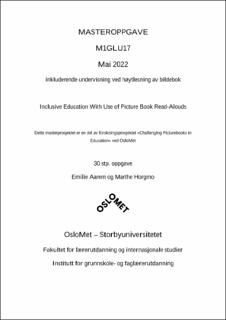Inkluderende undervisning ved høytlesning av bildebok
Master thesis
Published version
Permanent lenke
https://hdl.handle.net/11250/3026334Utgivelsesdato
2022Metadata
Vis full innførselSamlinger
Sammendrag
I denne oppgaven har vi undersøkt hvordan høytlesning av bildebok kan bidra til inkluderende undervisning i begynneropplæringen. I tillegg har vi undersøkt ulike årsaker til at bildeboka er en lite utnyttet ressurs i undervisningen i begynneropplæringen. Bakgrunnen for oppgaven er vår kunnskap om og interesse for bildebokas potensiale i skolen og mulighetene bruk av bildebok gir med tanke på tilpasset opplæring. Dette har vi undersøkt gjennom observasjon og intervju av tre lærere. Teori om inkluderende undervisning, dimensjoner innenfor inkluderende undervisning, bildeboka og høytlesning danner grunnlaget for analysen og diskusjonen av datamaterialet. Analysen av datamaterialet viser at høytlesning av bildebok kan bidra til inkluderende undervisning på flere måter. Et sentralt aspekt er høytlesningen i seg selv. Når lærere leser en bildebok høyt for elevene kan alle elevene få den samme teksterfaringen uavhengig av faglige forutsetninger. Dette danner et felles utgangspunkt for alle elevene, slik at de har like muligheter for å mestre videre arbeid. Et annet sentralt aspekt er bruken av bilder. Bildene i bøkene kommuniserer på måte som gjør at alle elevene kan delta i undervisningen. Bildene spilte en spesielt viktig rolle for elever med ulike språkutfordringer, og førte til at disse elevene fikk noe meningsfylt ut av fortellingen og undervisningen generelt. Organiseringen av høytlesningen hadde også betydning for inkluderingen. Dersom elevene fikk mulighet til å velge sittestilling selv og bevege seg under høytlesningen så det ut til at høytlesningen bidro til inkluderende undervisning i større grad. Analysen viser også at det var flere årsaker til hvorfor lærerne ikke utnytter bildeboka som en ressurs i undervisningen. Lærerne opplevde at de ikke hadde god nok tilgang på et oppdatert utvalg av bildebøker gjennom skolebiblioteket. De ga uttrykk for at de hadde brukt bildebøker i undervisningssammenheng oftere, dersom bildebøkene var lettere tilgjengelig. De trakk også frem at lærerhverdagen er hektisk, og at de derfor heller velger å bruke ferdige opplegg i læreverkene, istedenfor å bruke tid på å lage egne opplegg rundt en bildebok. Funnene i denne oppgaven er kun basert på et lite utvalg av lærere og det er derfor behov for mer forskning på feltet for å komme med en generell konklusjon. Arbeidet med denne oppgaven har likevel økt vår kunnskap om bildebokas potensiale i skolen og viktigheten av en inkluderende undervisning. Dette er kunnskap vi vil ta med oss inn i vårt eget arbeid som lærere. In this master thesis we have researched how a picture book read-aloud can contribute to inclusive education in early childhood education. We have also researched various reasons why picture books are often not utilized as a resource in lessons in early childhood education. The background for the thesis is our knowledge and interest in the picture book’s potential in education, and the possibilities the picture book gives for adapting education based on different student needs. Our research is based on observation and interview of three teachers. We observed a lesson that the teachers had planned based on our thesis. After the observation we interviewed the teachers about the lesson, the planning of the lesson and other relevant topics. We use theories on inclusive education, dimensions within inclusive education, picture books and read-alouds to analyze and discuss our thesis. The analysis of the data material shows that picture book read-alouds can contribute to inclusive education in several ways. A key aspect is the read-aloud in itself. When teachers read a picture book aloud for the students, all the students get the same text-experience, despite their academic prerequisite. Another key aspect is the use of pictures. The pictures in the books communicate in a way that makes it possible for all the students to participate in the lesson. The pictures played a particularly important role for students with different language challenges, since the pictures made it easier for the students to understand the story. The organization of the picture book read-aloud also had an impact on the inclusion. If the students could choose their sitting position themselves and were allowed to move during the read-aloud, the read-aloud had opportunities to contributed to inclusive education to a greater extent. The analysis also shows that the teachers choose picture book for the inclusive read-aloud, based on several different factors. It was important for the teachers that they already were familiar with the book, since it made it easier for them to convey the different elements in the picture book in a good way. It was also important for the teachers that the theme in the picture book appealed to the students, since they experienced a greater engagement from the students if the picture book was about something the students were interested in or could relate to. The teachers also chose the picture book based on different student needs. The analysis also shows that there are several different reasons why teachers don’t use a picture book as a resource in their lessons. The teachers indicated that they did not have good enough access to an updated selection of picture books through the school library. They expressed that they would have used picture books in lessons more often, if the picture books were more accessible. They also pointed out that they often don’t have much time to plan lessons in their job as a teacher. Because of their lack of time, they would rather use lesson plans that come with the teaching materials their school provided, than plan a lesson based on a picture book themselves. This study is based on a small selection of teacher and there is therefore a need for more research in the field to come to a general conclusion. Our work with this thesis has nevertheless increased our knowledge of the picture book’s potential in education and the importance of inclusive education. We will bring this knowledge with us into our profession as teachers.
